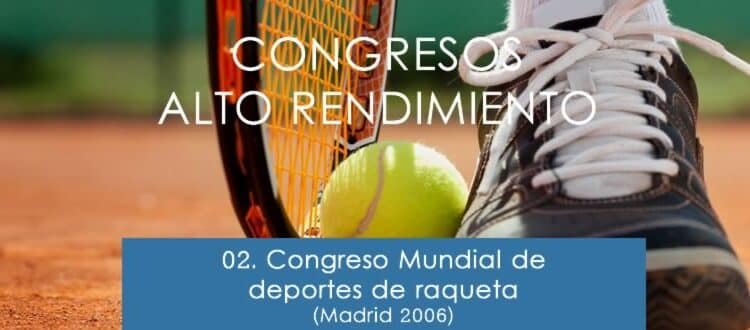Nordic walking in the physical preparation of racket sports players
Resumen nordic walking in the physical preparation of racket sports
Physical conditioning and strength training, as well as modern physical fitness diagnostic procedures are becoming ever more important in the contemporary sports training process, including racket sports. In the course of racket sports history, systematic programmed training has become more important after attack strokes have been introduced. Numerous injuries to the shoulder girdle muscles compel us to investigate strains to which individual muscles are prone in the execution of certain racket sports strokes. Some specific tests allow the measurement of specific fundamental factors that are assumed to be important in the performance. These factors, once they are measured, can then be evaluated and appropriate training strategies developed to provide for the improvement of any weaknesses. Sports preparation is aimed at improving efficacy of the various physiological systems of the body (cardio-vascular, respiratory, muscle-skeletal, etc.) in order to make them able to function efficiently at the higher levels required in competition. The primary goal of the best training system is the maximal performance in the shortest time with the least effort (Kondri? and Furjan-Mandi?, 2002). Nordic Walking is relatively new activity, but many investigations about utility on cardio vascular and motor abilities have been made (Rodgers et all, 1995, Church et al, 2002, Jordan et al, 2001, Morss et al, 2001.) Nordic Walking is an effective way of walking with poles. The swing of the arms and the powerful placement of the pole, influence the length of strides. A small arm swing means a limited pelvis rotation and shorter stride length. When the pole movement is bigger, the length of stride will also increase as well as the rotation in the pelvis and higher parts of upper body. By making the use of arm movements and good Nordic Walking technique, almost all muscles of the body are trained (INWA Instructor manual). There are many possibilities how to use NW in physical preparation of racket sports players. It depends on aim of training (flat terrain, uphill, downhill, strength exercises, stretching with poles). But, to achieve all the promised benefits from NW is necessary to learn good technique.
Introduction
Nordic Walking is a form of kinesiologic activity already known in Western Europe for several years. This activity influences the entire body muscle activation. Moreover, with (especially designed) poles it is also possible to apply strength development exercises, as well as stretching. In this way, the work intensity comes to a level which enables maximum use of lipids possible in training, with simultaneous strengthening of the shoulder area, arms and the upper body. Research results in Scandinavian countries show the fact that Nordic Walking is 40-50% more efficient than walking without poles. The new form of activity, which in the last years spread throughout all Scandinavian countries, Central and Western Europe, Asia and America, arrived to Croatia as well. It was first launched in Finland, as a running training on skis in summer. It involves long walking on flat or hilly terrain, where at the beginning the poles were used as help for balance, and in time their function became more complex. Nordic Walking is a trend in recreation; however it is also used during physical preparation of athletes. Nordic Walking (walking with poles) should not be confused with hiking, because poles and walking technique are not the same. Special poles are used in Nordic Walking, which resemble the poles for cross-country skiing; however they are shorter and adjusted for walking on all kinds of surfaces. Many will say that hiking poles are the same, however in comparison to the hiking ones, Nordic Walking poles are completely different. Anatomically made grips, with a strap adjustable to the size of a fist (hand), makes it possible to actively include the work of the shoulder area, arms and the upper body. The end of poles has a metal spike, used for walking on soft ground (it prevents sliding of the pole on the ground). A rubber paw (ending) is used for walking on the asphalt, which is put on spike tips, for preventing the pole sliding and for better grip. The ending design is bended as to make possible the push off from the pole under an ideal angle, as well as feeling secure while walking. The rubber ending is made of a material similar to a car tire, which provides good contact with the ground.
Choosing a correct pole length
1.1 Walking technique Learning Nordic Walking should always start on a flat terrain. The rhythm of arm and leg movements is the most important in Nordic Walking. It is the same as the fast walking rhythm however, due to the push off from the pole, it is important to learn the correct arm movement and to synchronize it with the legwork in order to achieve the best exercise effect. The push off from the pole starts with a bent arm close to the body and ends with a completely stretched arm behind the body. This phase requires maximum engagement of forearm extensor muscles and good flexibility in the shoulder joint. During correct performance, the upper arm triceps (three-headed) muscle contracts to the maximum, and during the use of the pole, the same happens with pectoral major muscle and shoulder muscles. Poles are held close to the body. The push off from the pole starts simultaneously when the opposite heel touches the ground, and it ends when the front part of the foot pushes off the ground. At the same time, a hip of the same leg lifts up and upper torso rotates toward the pole, which makes torso muscles activate as well. At the same time, the torso is slightly leaning forward. By activating the upper body, walking becomes more efficient, heart frequency is raised, and the coordination of arm and legwork is improved. By using the poles, or rather by pushing off from them, walking or running tempo is determined. The correct work of arms and legs is a condition for quality exercising.
1.2 Running with poles It is also possible to use Nordic Walking poles for running, although that technique requires good coordination from an athlete. In running with Nordic poles, arm movement is, in a way, «slower» than in normal running, except during the last phase of the arm movement, i.e. after pushing off from the pole and before the next pole thrust. Running can also be performed with an emphasized push off, and above all, its purpose is for athletes who want to increase jumping abilities or anaerobic abilities. 1.3 Strength and flexibility exercises Beside improving aerobic and anaerobic abilities, the Nordic Walking poles can also be used to perform exercises for strength and flexibility development.
Uphill Walking During uphill walking, the body slightly leanes forward (depending on inclines). Arms are more active because the back part of the leg is used to a greater extent, especially the lower leg part. With stronger pushing off from the pole, the stride becomes longer. Stronger pole thrust while walking uphill reduces the load of legs and increases the load of the upper body. Walking uphill is a good training for beginners as well, because it helps learning the use of the arms. While walking uphill, the athletes learn faster how to push off correctly from the pole because the uphill «forces» them to stretch their arm during the push off. Downhill Walking When walking downhill, the stride is shortened and the center of gravity is held lower because the knees are bent the whole time. The upper body leans backwards, and it depends on the incline. The body weight is shared between the pole striking the ground and the heel of the opposite foot. The greater the pression taken by the pole, the less weight is borne on the opposite leg on the ground. This way, the load on the upper body increases. While walking downhill, the poles do not extend in front of the body, but behind it. Depending on the terrain inclines, one-hand or two-hand push off from the poles will be used. Nordic walking and injury prevention Warm-up must be a mandatory part of every training. After training, it is recommended to implement stretching exercises for all parts of the body, regardless of which kind of walking was performed. The purpose of stretching exercises at the end of training is to lower the pulse and to relax muscles. If the stretching exercises are executed correctly, the organism will recover quicker due to better muscle blood circulation. Better blood circulation also means that piled up lactic acid will be removed faster from muscles, which every trainer is familiar with. On the other hand, stretching exercises increase body flexibility; they are good prevention of injuries, which might occur due to sudden stretch or possible fall during walking. Possibilities It is interesting for athletes to chose different types of terrain (hills, sand, pebbles, …). However, regardless of a basic preparation of an athlete, it is necessary to learn the Nordic Walking technique well, for bigger possibility of applying it, as well as easier and correct load dosage.
Bibliografía
- 1. Anttila, R., Holopainen, S. & Jokinen (1999.) Pole walking and the effect of regular 12-week pole walking exercise on neck and shoulder symptoms, the mobility of the cervical and thoracic spine and aerobic capacity. Final project work for the Helsinki IV College for health care professionals, 2005 from http:/ www.nordicwalking.com/research
- 2. Church, T.S., Earnest, C.P., & Morss, G.M. (2002). Field testing of physiological responses associated with Nordic Walking Res Q Exerc Sport. 73(3):296-300
- 3. Furjan-Mandi?, G., & M. Kondri? (2005). Nordijsko hodanje – nova aktivnost u fizi?koj pripremi sportaša= Nordic walking-new activity in physical preparation of sportsman. In: SEKULI?, Damir (ur.). Me?unarodno znanstveno-stru?no savjetovanje “Sport-rekreacija-fitnes” : zbornik radova. Split: Zavod za kineziologiju, Fakulteta prirodoslovno matemati?kih znanosti i odgojnih podru?ja, Sveu?ilišta u Splitu, 2005, p.p. 165-168.
- 4. Jordan, A.N., Olson, T.P., Earnest, C.P., Morss, G.M., & Church, T.S. (2001). Metabolic cost of high intensity poling while Nordic walking versus normal walking. Medicine and Science in Sports and Exercise 33. (5 Supplement): p: S86.
- 5. Kondri?, M., G. Furjan-Mandi? & A. Švent (2003). Nordijska hoja na son?ni strani Alp=Nordic walking on the sunny side of the Alps. Šport (Ljublj.), 51(3):17-19.
- 6. Morss, G.M, Church, T.S., Earnest, C.P., & Jordan, A.N. (2001). Field test comparing the metabolic cost of normal walking versus Nordic walking. Medicine and Science in Sports and Exercise 33 (5 Supplement): p: S23.
- 7. Porcari, J.P., Hendrickson T.L., Walter, P.R., Terry, L., & Walsko, G. (1997). The physiological responses to walking with and without power poles on treadmill exercise. Res Q Exerc Sport. 68(2):161-6.
- 8. Rodgers C.D., VanHeest, J.L., & Schachter, C.L. (1995). Energy expenditure during submaximal walking with exerstriders. Med Sci Sport Exerc. 27(4):607-11
















